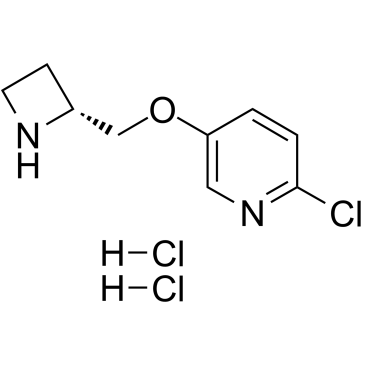Tebanicline dihydrochloride (Synonyms: Ebanicline dihydrochloride; ABT-594 dihydrochloride) |
| Catalog No.GC61317 |
Tebanicline dihydrochloride(Ebanicline dihydrochloride)는 강력하고 경구적으로 효과적인 진통 활성을 가진 nAChR 조절제입니다.
Products are for research use only. Not for human use. We do not sell to patients.

Cas No.: 209326-19-2
Sample solution is provided at 25 µL, 10mM.
Tebanicline dihydrochloride (Ebanicline dihydrochloride) is a nAChR modulator with potent, orally effective analgesic activity. It inhibits the binding of cytisine to α4β2 neuronal nAChRs with a Ki of 37 pM[1].
Tebanicline is a novel, potent cholinergic nAChR ligand with analgesic properties that shows preferential selectivity for neuronal nAChRs. It inhibits the binding of cytisine to α4β2 neuronal nAChRs with a Ki of 37 pM. Functionally, tebanicline is an agonist. At the transfected human α4β2 neuronal nAChR in K177 cells, with increased 86Rb+ efflux as a measure of cation efflux, ABT-594 has an EC50 value of 140 nM with an intrinsic activitycompared with (-)-nicotine of 130%; at the nAChR subtype expressed in IMR-32 cells, an EC50 of 340 nM; at the F11 dorsal root ganglion cell line, an EC50 of 1220 nM; and via direct measurement of ion currents, an EC50 value of 56,000 nM at the human α7 homo-oligimeric nAChR produced in oocytes[1]
Tebanicline is a potent antinociceptive agent with full efficacy in models of acute and persistent pain and that these effects are mediated predominately by an action at central neuronal nAChRs[2]. Tebanicline produces significant antinociceptive effects in mice against both acute noxious thermal stimulation. ABT-594 is orally active, but 10-fold less potent by this route than after i.p. administration. The antinociceptive effect of ABT-594 is prevented, but not reversed, by the noncompetitive neuronal nicotinic acetylcholine receptor antagonist[3]. Tebanicline has antinociceptive effects in rat models of acute thermal, persistent chemical, and neuropathic pain. Direct injection of tebanicline into the nucleus raphe magnus (NRM) is antinociceptive in a thermal threshold test and destruction of serotonergic neurons in the NRM attenuates the effect of systemic tebanicline[4].
[1]. Donnelly-Roberts DL, et al. ABT-594 [(R)-5-(2-azetidinylmethoxy)-2-chloropyridine]: a novel, orally effective analgesic acting via neuronal nicotinic acetylcholine receptors: I. In vitro characterization.J Pharmacol Exp Ther. 1998 May;285(2):777-86. [2]. Bannon AW, et al. ABT-594 [(R)-5-(2-azetidinylmethoxy)-2-chloropyridine]: a novel, orally effective antinociceptive agent acting via neuronal nicotinic acetylcholine receptors: II. In vivo characterization. J Pharmacol Exp Ther. 1998 May;285(2):787-94. [3]. Decker MW, et al. Antinociceptive effects of the novel neuronal nicotinic acetylcholine receptor agonist, ABT-594, in mice. Eur J Pharmacol. 1998 Apr 3;346(1):23-33. [4]. Decker MW, et al. The role of neuronal nicotinic acetylcholine receptors in antinociception: effects of ABT-594. J Physiol Paris. 1998 Jun-Aug;92(3-4):221-4.
Average Rating: 5 (Based on Reviews and 1 reference(s) in Google Scholar.)
GLPBIO products are for RESEARCH USE ONLY. Please make sure your review or question is research based.
Required fields are marked with *




















